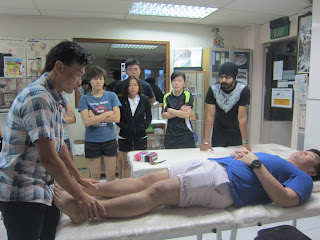 |
| Picture by Lord Jim from Flickr |
I've previously written on the
Paleolithic or
caveman diet before, which typically consists of hunted meats and fish and food that can be gathered like eggs, insects, fruits, seeds plants and herbs etc.
As a result you're supposed to get healthier, low fat protein, healthier fats and much less dairy and grain (or carbohydrates) than what we normally eat today.
A recent published article however suggests that the Paleo diet did in fact consist of lots of starchy carbohydrates.
The researchers put together information from genetics, archaeology, physiology and nutrition to come up with a theory that our Paleolithic ancestors did actually eat starchy plants like potatoes and possibly even cooking them over fires.
They also suggested that eating carbs help made our brains larger. Without carbs, we may be very different today. We may also not be runners like we can be now.
The authors wrote that carbohydrates are essential for long distance running which is how our ancestors chased down and captured prey. We get energy from glycogen stored n our bodies during vigorous exercise. Our glycogen stores normally lasts about 20 miles (or 32 km) and
if you don't eat or drink, you'll hit the wall.
Even evolutionary biologist Daniel Liberman, who has written so much about humans and barefoot running said "The idea that people shouldn't eat carbohydrates is just silly, we've been eating carbohydrates for a long time."
Lieberman however isn't convinced that carbs helped Paleo hunters run better. His research suggested that Paleo hunters who chased down their prey didn't have to run that fast as they actually walked and ran. At those speeds (to keep up with a wounded prey usually) they may not need a lot of carbohydrates. Their bodies probably used more fat instead.
I've written before that
relying on fat may help running performance. This is especially true if you have trained your body to use fat as fuel (which our bodies have plenty). It allows us to run further without hitting the wall.
Some have proposed that this may be better for ultra marathon distances (since you tend to run slower). However as speed increases, carbohydrates tend to be vital, especially if you want to run long and fast, suggested Lieberman.
Do take note that the carbs our Paleo ancestors ate were complex carbohydrates and not the overly processed and refined carbohydrates we get on supermarket shelves today.
The authors suggested that we need to be careful when trying to replicate ancestral diets as we still do not know exactly what Paleo man ate.
Looks like you can and should eat complex carbs, especially if you wanna race long and fast.
Reference
Hardy K, Brand-Miller J et al (2015). The Importance Of Dietary Carbohydrate In Human Evolution. The Quarterly Review Of Biology. 90(3): 251-268. DOI. 10.1086/682587.
 |
| Cavemen and dinosaurs? by Orln Zebest from Flickr |
















